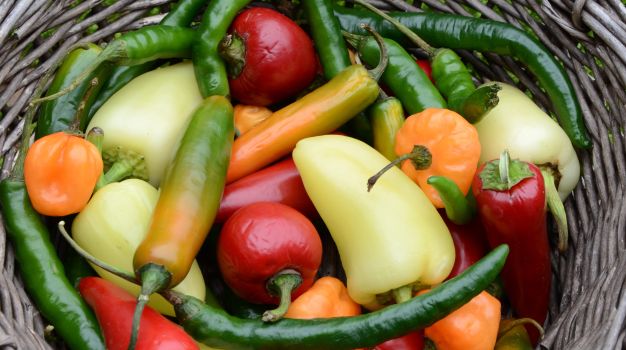Peppers, which spread globally from the New World, were put to new and exciting uses everywhere they went. Although heat-loving, they were welcome even in northern countries such as Hungary, which became famous for its paprika. An accommodating crop for home gardeners, most require no staking and fit well in small spaces - even planters and pots.
You might think it's all about looks. Even "green" peppers rarely stay that way, but progress to yellow, orange, red, chocolate brown or even a lustrous nearly-black purple hue, as with Purple Beauty from Pinetree Garden Seeds.
Often you get several color changes in sequence and can thereby grow a rainbow mix on one plant as the peppers mature. Purira from Seeds of Change is one such variety. With a pepper called Fish, carried by Seed Savers Exchange and others, the fruits are colorfully striped, with variegated foliage to boot. Filius Blue, from Baker Creek and West Coast Seeds, is a jewel box of multicolored little balls, nestled among blue-green leaves.
In the end, though, flavor counts the most. Want the sweetest pepper ever? Fedco Seeds says it's their Amish Pimiento. The hottest? Many claim it's the legendary Ghost from India, known there as Bhut Jolokia. (Find it from Harris Seeds and elsewhere.) Some peppers taste richer and fruitier than others, and it pays to try new ones to see which please your own set of taste buds.
Wise seed sellers match peppers with the dishes a gardener-cook might want to make. For stuffing, R.H. Schumway's recommends its Chinese Giant, six inches across. I'm drawn to Johnny's Selected Seeds' Eros and Cupid or Burpee's Cherry Stuffers, for a platter of babies you can eat in one or two bites. Cooks like a thick-walled pepper for stuffing and for slicing as well - maybe Pizza Pepper from Territorial Seeds.
For pickling or for pepper vinegar, there's the Pennsylvania Dutch heirloom Hinkelhatz ("Chicken Heart"), named for its shape, from Fedco Seeds and Seed Savers Exchange. For sweet ground spice pepper, Alma Paprika (from Territorial Seed and others) has long been a favorite, but for hot spice I'd sample Cyklon from Seed Savers. It dries well because of its thin-walled structure. To jazz up crab cakes, the obvious choice is the aforementioned Fish, named for its traditional use at Chesapeake Bay oyster and crab houses.
As cooks get more adventurous, we want to grow ingredients that will make our ethnic dishes more authentic. For Japanese cookery, try the peppers from Kitazawa Seed, which also sells Thai varieties for curries.
Mexican cookery is very popular, and everyone must be making chiles rellenos, judging by the number of ancho/poblano peppers, so essential to that recipe, being sold. Territorial sells a large one called Mulato Isleno, as both seeds and plants. For a Oaxacan mole, I'm intrigued with Pasillo Bajio from John Scheepers Kitchen Garden Seeds. It's a medium-hot pepper that's allowed to dry on the plant, where it turns a dark brown. Scheepers also tells you how to roast its Basque Piquello peppers as well as what to do with its de Padrons: Fry them in oil, sprinkle with sea salt and black pepper, then, "holding the stem, eat whole with a cool beer." Summer cannot come soon enough for that.(c) 2016, The Washington Post











